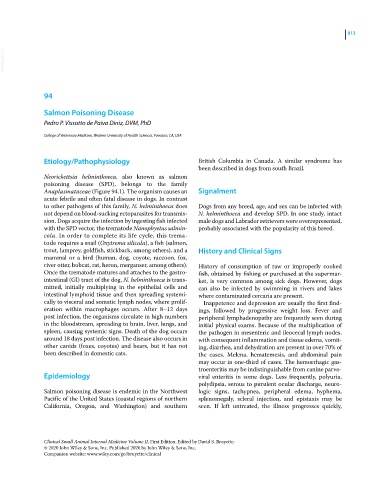Page 975 - Clinical Small Animal Internal Medicine
P. 975
913
VetBooks.ir
94
Salmon Poisoning Disease
Pedro P. Vissotto de Paiva Diniz, DVM, PhD
College of Veterinary Medicine, Western University of Health Sciences, Pomona, CA, USA
Etiology/Pathophysiology British Columbia in Canada. A similar syndrome has
been described in dogs from south Brazil.
Neorickettsia helminthoeca, also known as salmon
poisoning disease (SPD), belongs to the family
Anaplasmataceae (Figure 94.1). The organism causes an Signalment
acute febrile and often fatal disease in dogs. In contrast
to other pathogens of this family, N. helminthoeca does Dogs from any breed, age, and sex can be infected with
not depend on blood‐sucking ectoparasites for transmis- N. helminthoeca and develop SPD. In one study, intact
sion. Dogs acquire the infection by ingesting fish infected male dogs and Labrador retrievers were overrepresented,
with the SPD vector, the trematode Nanophyetus salmin- probably associated with the popularity of this breed.
cola. In order to complete its life cycle, this trema-
tode requires a snail (Oxytrema silicula), a fish (salmon,
trout, lamprey, goldfish, stickback, among others), and a History and Clinical Signs
mammal or a bird (human, dog, coyote, raccoon, fox,
river otter, bobcat, rat, heron, merganser, among others). History of consumption of raw or improperly cooked
Once the trematode matures and attaches to the gastro- fish, obtained by fishing or purchased at the supermar-
intestinal (GI) tract of the dog, N. helminthoeca is trans- ket, is very common among sick dogs. However, dogs
mitted, initially multiplying in the epithelial cells and can also be infected by swimming in rivers and lakes
intestinal lymphoid tissue and then spreading systemi- where contaminated cercaria are present.
cally to visceral and somatic lymph nodes, where prolif- Inappetence and depression are usually the first find-
eration within macrophages occurs. After 8–12 days ings, followed by progressive weight loss. Fever and
post infection, the organisms circulate in high numbers peripheral lymphadenopathy are frequently seen during
in the bloodstream, spreading to brain, liver, lungs, and initial physical exams. Because of the multiplication of
spleen, causing systemic signs. Death of the dog occurs the pathogen in mesenteric and ileocecal lymph nodes,
around 18 days post infection. The disease also occurs in with consequent inflammation and tissue edema, vomit-
other canids (foxes, coyotes) and bears, but it has not ing, diarrhea, and dehydration are present in over 70% of
been described in domestic cats. the cases. Melena, hematemesis, and abdominal pain
may occur in one‐third of cases. The hemorrhagic gas-
troenteritis may be indistinguishable from canine parvo-
Epidemiology viral enteritis in some dogs. Less frequently, polyuria,
polydipsia, serous to purulent ocular discharge, neuro-
Salmon poisoning disease is endemic in the Northwest logic signs, tachypnea, peripheral edema, hyphema,
Pacific of the United States (coastal regions of northern splenomegaly, scleral injection, and epistaxis may be
California, Oregon, and Washington) and southern seen. If left untreated, the illness progresses quickly,
Clinical Small Animal Internal Medicine Volume II, First Edition. Edited by David S. Bruyette.
© 2020 John Wiley & Sons, Inc. Published 2020 by John Wiley & Sons, Inc.
Companion website: www.wiley.com/go/bruyette/clinical

